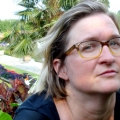Howdy, Stranger!
It looks like you're new here. If you want to get involved, click one of these buttons!
Categories
In this Discussion
Code Critique: Processing Samples from The Nature of Code
The title of Daniel Shiffman's The Nature of Code is a play on words. The book, which promises information about "simulating natural systems with Processing," is both a treatise intended to reveal the "nature of" code in the sense of its essential properties -- how code is structured and how it executes -- and a volume that shows how code can imitate the principles of natural systems.
For a long time feminist critics have argued that it is difficult to talk about nature without talking about gender. In Reflections on Gender and Science," Evelyn Fox Keller argues that the articulation of the scientific method by Francis Bacon was full of gendered language about penetrating nature and dominating nature in ways analogous to rape of women by men. In Technologies of the Gendered Body Anne Balsamo asserts that such gendering nature female and technology male perpetuates old stereotypes and ignores the legacies of mothers who were computers, like Balsamo's own female programmer-parent.
Using the programming language Processing, the library of Code Examples that Shiffman has archived on GitHub covers a range of topics, including vectors, forces, oscillation, particle systems, physics libraries, autonomous agents, cellular automata, fractals, the evolution of code, and neural networks.
In the course on Feminist Digital Humanities at the Digital Humanities Summer Institute, Jacque Wernimont, Jessica Marie Johnson, and I have encouraged participants to explore Shiffman's code samples to think about how the relationships of agents and environments that might seem "natural" in the "real world" might be challenged and reimagined differently from conditions of hierarchy, division, and oppression.
Feminist critics interested in vibrant matter, queer animacies, and the so-called "new materialism" -- such as Jane Bennett, Mel Chen, and Rosi Braiddotti -- might also be interested in the vitalism of Shiffman's code samples. (To see some of his ideas about how non-human agents might have steering forces, you can check out Shiffman in action in this video.)

Perhaps it might be useful to look at the program for "simple inheritance," which isn't in the book. As Shiffman explains, inheritance "allows us to write a class that inherits variables and functions from another class, all the while implementing its own custom features." Although some of his writing about "attraction" and "completeness" in other programs might seem problematic, in the simple inheritance program I found myself enjoying how Shiffman might undermine the simple visual binary of the circle and the square, by pointing out how a "generic shape does not really know how to be displayed."
Speaking of inheritance, I also appreciated Shiffman's dedication of _The Nature of Code _ to his grandmother Bella Manel: "A Pioneering woman in mathematics, she earned her PhD in 1939 from New York University under the supervision of Richard Courant. She worked for Ram-Wooldridge (now TRW) and at the Rand Corporation with Richard Bellman." Since I wrote about female RAND programmers for Pat Harrigan and Matthew Kirschenbaum's Zones of Control, it made me want to return to the RAND archive to look for Shiffman's matrilineal progenitor.

Comments
Contingently, about his Squared Circle, Fred Truck writes:
Fred also used his ArtEngine to combine Minnie Mouse and Mickey Mouse.